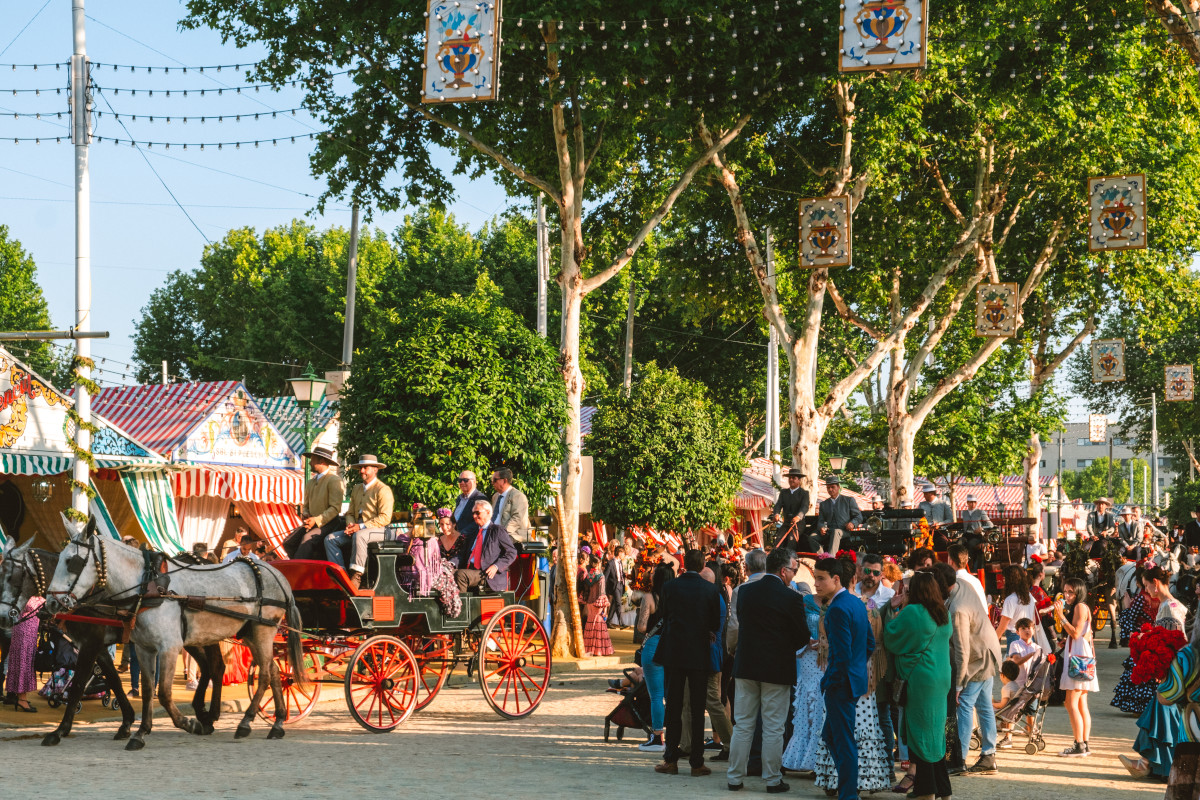Seville’s two biggest annual festivals
This post explains two of the most important weeks in Seville’s calendar, leading up to and just after Easter. The first is the Semana Santa (Holy Week in English), and it’s unforgettable for anyone who’s experienced it. Every evening, sombre candle-lit processions wind through the streets to commemorate the last week of Christ’s life on earth. Two weeks later comes the Feria de Abril, originally a trade fair, but really a huge excuse to party in Andalusian style. Think horses and carriage-riding, flamenco, tapas and dancing till dawn for six nights in a row.
semaNa santa


Seville’s commemoration of Christ’s Passion, Death and Resurrection lasts from Palm Sunday until Easter Sunday. ‘Brotherhoods’ from the local churches process through the streets to the cathedral every evening in preparation for the Easter celebrations. The tradition started in the 16th century, as the catholic church sought to reassert its authority after the Reformation. Each of the 50 or so Hermandades (Brotherhoods) has prepared a float, usually featuring a statue of Christ or the Virgin Mary and decorated in flowers and candles, which they carry on their shoulders to the cathedral. There is a set day and time for every procession, which you can check by buying a Programa de la Semana Santa or consulting this website.
The atmosphere is unique. The penitents are dressed in long robes and conical hats, their faces covered in masks, modest clothing which may remind you of – but in fact long pre-dates – the Klu Klux Klan. They process to a solemn drumbeat, broken now and then by ‘saetas’, haunting Andalusian religious songs which retell the stories of Easter week. Elizabeth Nash, author of Seville, Cordoba and Granada, described the scene as follows: ‘Every sound is magnified, as hushed onlookers crane from balconies, hold their breath, cross themselves and toss petals and orange blossom the length of the street.’
la macarena


Visiting the Macarena Church is a good way to see a little of the Semana Santa. Its 12 metre altar of solid silver was built to house the church’s Virgen de la Esperanza Macarena, the 17th century model of the Virgin Mary which features in the Holy Week procession every year. She is in tears, her hands spread in a pleading gesture, and dressed in a white dress, pale blue cloak and golden crown, with a huge golden halo above her. She wears 5 diamond and emerald brooches, a gift from Joselito, one of Spain’s best known 20th century bullfighters. The Virgen leaves the church every year at midnight on Maundy Thursday and is carried aloft through the streets on a six-hour journey to the cathedral.
the feria de abril



This 6 night annual fiesta, the largest in Andalucia, has its origins in a trade and livestock fair and it’s a spectacular event. A fairground is built specially and casetas, (stands or marquees) are added, some set up by families, others by local businesses. Many are for invited guests only, but some – listed here – are open to the public. During the day you will see people parading on horseback or in horse-drawn carriages, wearing traditional Andalusian clothes: young men in tight jackets, each sitting astride a horse, perhaps with a girl in a ruffled polka-dot dress and a a rose on her hair, riding side-saddle behind. There is a full programme of bull-fighting too, regarded as the best of the season.



The evenings are for partying: drinks, tapas, flamenco and music all around the Calle de Infierno, which means ‘Hell Street’ in English! Or, as the Andalucia.com website puts it, ‘This is a week of serious dancing, drinking, eating and socialising, with late nights – or all-nighters – the norm.’ The travel writer Jan Morris summed it up like this: ‘Everywhere there is the beat of flamenco, the clatter of heels and castanets, the creak of carriage wheels, the smell of horses, the swish of romantic skirts, the noise, like the shuttle of distant looms, of twenty thousand clapping hands.’
Also on the podcast: details of three ‘conventes de clausura’ or closed religious institutions where you can stop by to buy the sweet treats they make to raise funds:
the Convento de San Leandro (for sugary egg-yolk sweets)
the Convento de Santa Inés (for sweet buns and almond cakes)
the Convento Santa Paula (for jams, marmalades and a sweet called tocino de cielo which means ‘heavenly lard’!)
Listen to the POdcast
Reading suggestions
Seville, Cordoba and Granada: A Cultural and Literary History by Elizabeth Nash
Spain by Jan Morris
links for this post
Semana Santa programme
Macarena Church
Public access to the Feria de Abril
San Leandro Monastery
Santa Ines Convent
Santa Paula Convent
Previous Episode The Golden Age of Seville
Next Episode The Parks and the Palaces
Last Updated on August 9, 2023 by Marian Jones





